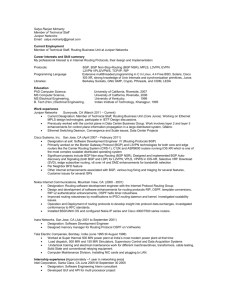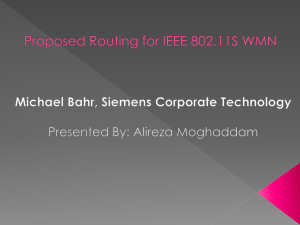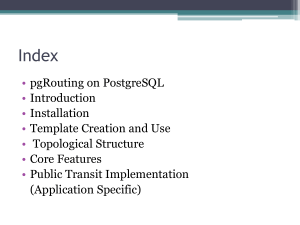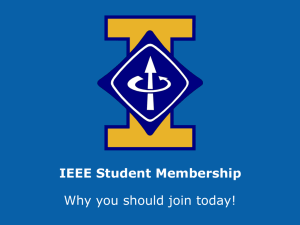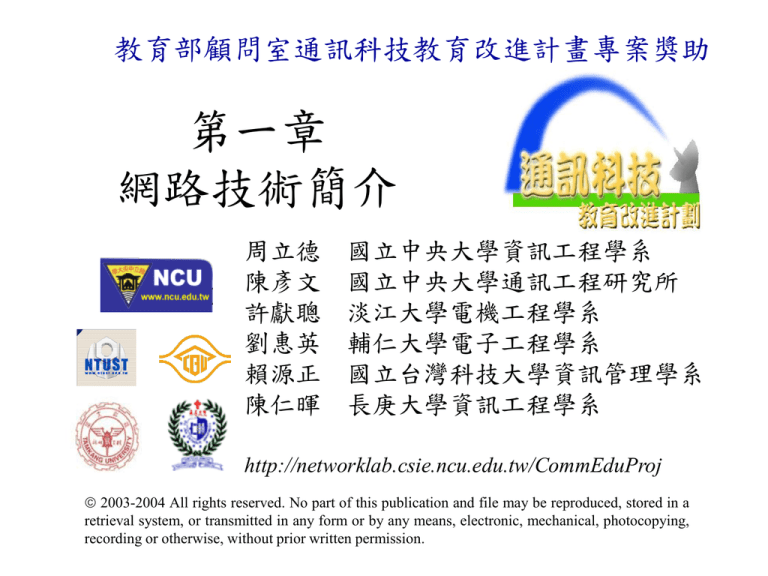
教育部顧問室通訊科技教育改進計畫專案獎助
第一章
網路技術簡介
周立德
陳彥文
許獻聰
劉惠英
賴源正
陳仁暉
國立中央大學資訊工程學系
國立中央大學通訊工程研究所
淡江大學電機工程學系
輔仁大學電子工程學系
國立台灣科技大學資訊管理學系
長庚大學資訊工程學系
http://networklab.csie.ncu.edu.tw/CommEduProj
2003-2004 All rights reserved. No part of this publication and file may be reproduced, stored in a
retrieval system, or transmitted in any form or by any means, electronic, mechanical, photocopying,
recording or otherwise, without prior written permission.
1
第一章
資料與通訊
電路交換與分封交換
連結導向與非連結導向
通訊協定原理與架構
交換與繞路(Switching v.s. Routing)
2
資料與通訊
何謂資料?
IEEE對Data的定義為 -- A representation of facts, concepts, or
instructions in a formalized manner suitable for communication,
interpretation, or processing by human or automatic means.
傳統上,人們將數據或文件等視為資料(Data);當通信
技術成為日常生活的一部份後,發現除了語音可通信
外,數據及視訊通信也是重要的應用。
資訊 --- 包含 Voice, Data, Fax, Video, etc.
資料與通訊
資訊需依據各中種不同處理及應用的需要,做適當的
格式(Format)轉換以另一種方式表達(Representation)。
Functions, Works, ----> Program
Program ----> Assembly code, Machine code (Processor-dependent)
流水帳 ----> 各種有意義的報表
非標準格式資料(資訊) ----> 共通、標準且易於處理的格式
任何資訊要在通信網路上傳送,也必須將資訊
Represent成適合通信的格式。
資料與通訊
對目前網路而言,資訊大都先轉為Digital(0與1的信號)
後,再在網路上傳送。
數位傳送的資訊對不同的應用,各有不同的意義及格
式。例如:數據資料用的ASCII, EBCDIC碼、語音的
A-Low、u-Low、視訊的MPEG等。
0與1在傳輸線上的表現方式:
1
•
0
+Voltage
0 Volts
較常用的表現方式則包括Unipolar, Bipolar, RZ, 及NRZ幾種
資料與通訊
Data
Conversion
Compress.
Digital
Signals
Transmission
Data
Conversion
Sampling
Uncompress.
ADC
Data conv./
Compres.
Analog
Signals
Transmission
Filter
DAC
Data conv./
Uncompres.
6
資料與通訊
類比與數位信號之轉換
轉換步驟:
• 取樣(Sampling) 取樣頻率(sampling rate)
• 量化(Quantization) 量化解析度
Quantization
Sampling rate
7
資料與通訊
依Nyquist criterion:若取樣後之信號要能
被還原成原始之信號,則取樣頻率需為
原始信號最高頻率的兩倍。
人類聲音頻率:0~4K Hz
聲音(類比)信號轉為數位信號時,其取樣頻
率需為8000 samplings/sec.
8
電路交換與分封交換
交換 – A端的資料給B端,B 端的資料給A端
電路交換 - 網路提供一條專屬(Dedicate)的通路
(Channel)專供收/送兩端專用。
以『電路』做為交換的單位;例如: 電話網路等
分封交換 - 網路提供通信資源(通路、頻寬等)
給大家共用,並未專屬於任一使用者使用者將
資料分裝成符合網路標準的資料封包(Packet),
由網路送到收端。
以『封包』做為交換的單位;例如: Internet, X.25
網路等
虛擬電路(Virtual circuit)
9
電路交換與分封交換
網路
電路交換
B, A
A, B
B, C
A, C
B
網路
A
C, B
C
資料封包
分封交換
10
電路交換與多工
利用語音125us取樣一次(每次8個Bit),及多工的方式
可將多個Channel收容在一對線上傳送
125us
‧‧
1
2
125us
n-1 n
Frame
n個channels的多工
125us
電路交換與多工
北美標準PCM第一級多工(T1 or DS1)為24個Channels,即
每一Frame(125us duration)含24channels,8bits/ch,但每一Frame均
有一個bit做為Framing bit (added bit framing),因此,
每一Frame共有 8x24+1= 193 bits
T1的速率:193bits/125us = 1544K bits/sec = 1.544Mbps
歐洲標準PCM第一級多工(E1)為32個Channels,即
每一Frame(125us duration)含32channels,8bits/ch,每一Frame的
第0個Time slot (channel)做Synchronization,沒有Framing bit
(added channel framing),因此
每一Frame共有 8x32 = 256 bits
E1的速率:256bits/125us = 2048K bits/sec = 2.048Mbps
網路上傳送的訊息,包括
Signaling
• Supervision Signal (監視網路及用戶狀態)
• Control and Registration Signal (Addressing and Handshaking)
User Information
• End-to-end message (對網路為透通性)
Network
電路交換與多工
Signalling Channels
T1/DS1:
“盜取”每第6個及第12個Frame的最右邊Bit (Least
Significant Bit, LSB)
----> 每一channel由64KBps減為56KBps
E1:
• 第16個channel固定做為Signalling Channel
----> 真正提供給User使用為30channels
分封交換與封包
為何要把資料分裝成封包傳送
Error control
Congestion/flow control
Resource sharing
• Buffer management
• Scheduling management
Chop a message/file into packets/frames
15
分封交換與封包 - Packet v.s. Frame
Packet more logical or software view on
the concept of small block of data
Frame more hardware or network
dependent
16
電路交換與分封交換
電路交換與分封交換之特性差異
阻塞(Blocking) v.s. 擁塞(Congestion)
延遲(Delay)特性
路由方式
17
連結導向與非連結導向
連結導向(Connection oriented) -- 送端要送資
料前先通知(by signalling或人工)網路,建立收/
送端的通道。
---> 電路交換一定是Connection oriented。
非連結導向(Connectionless) -- 送端要送資料前,
毋須先行建立收/送端的通道,但在每一送出之
封包,均要註明收端住址(Address),網路依其
收端住址將資料送達目的地。
----> 分封交換有可能是Connection oriented也可能是
Connectionless。
連結導向並不一定在網路上要有實質的連線。
18
通訊協定原理與架構
通訊協定:為提供網路上終端設備及網路設備
彼此間通訊的便利性及效率,通訊的雙方需遵
循一定的“規則”;亦即雙方需訂定協定
(Protocol)共同遵守。
為對通訊所需之功能有系統之設計與規劃
通訊協定參考模式 (Reference Model)
為配合網路不同的應用需求,可將通訊所需之
功能以堆疊的方式分層(Layer)達成。
19
資料通信的基本定義是將Represent過的資料經由網路,
以雙方同意的特定格式傳送,達到所要求的目的。
Voice
Network
Network Architecture
Protocol
Signaling
Interface
Video
Interface
Data
Voice
Data
Video
通訊協定原理與架構
OSI參考模式(OSI Reference Model)
7- Layer Reference Model
同一層級的兩通訊端點稱為Peer-to-peer
下層透過Service Access Point (SAP)提供服務
給上層
同一層級的通訊雙方共同遵循的規則就
稱為該層的通訊協定。
通訊協定主要包括:
訊息傳送格式(Format)
訊息交握流程(Scenario)
21
通訊協定原理與架構
Layer N
Protocol (N)
SAP
SAP
.........
.........
SAP
Protocol (2)
Layer 2
SAP
Layer 1
Layer N
SAP
Layer 2
Protocol (1)
SAP
Layer 1
通訊協定原理與架構
通訊協定基本功能分類
Encapsulation/De-capsulation
Segmentation/Reassembly
Connection Establishing/release
Flow Control
Error Control
Multiplexing
Network control and management
Applications and services
通訊協定原理與架構 – OSI
Reference Model
應用層 (Application Layer)
High
Layer
表達層(Representation Layer)
會議層(Session Layer)
傳送層 (Transport Layer)
網路層 (Network Layer)
鏈結層 (Link Layer)
實體層 (Physical Layer)
Low
Layer 24
通訊協定原理與架構
實體層:傳輸媒介規格,例如,信號編
碼方式、clock rate、線材規格、接頭規
格等。
鏈結層:鏈路(Link)使用方式,例如:接
取規則、錯誤控制、流量控制等。
網路層:資料在網路傳送路徑(Path)之控
制,例如:網路位址(Address)、繞徑
(Routing)、連線控制等。
25
通訊協定原理與架構
傳送層:提供收/送之端點設備建立所需品質之資
料通道,例如:End-to-end錯誤控制、流量管制
等。
會議層:提供使用者對連線中所傳送資料之同步
與管理等功能,例如:續傳功能。
表達層:傳送資料(包括數據、語音、影像、多媒
體)之編碼方式,例如:加/解密、Transcoding等。
應用層:提供各種網路應用服務,例如:WWW,
ftp等
26
通訊協定原理與架構
Unique Flag (Pattern) in bit oriented protocol
Flag
Address Control
Information
FCS Flag
Flag - 01111110
Zero bit insertion technique - <i> Flag pattern為單一
<ii> 01111110的資訊能順利傳送
,不會混淆
方法 - 傳送資料時,逢五個連續1則插入一個0
通訊協定原理與架構
Error Detection and Error Correction
LRC
Error Detection
• Parity Check --- Odd/Even parity;
Vertical Redundancy check (VRC)
Longitudinal Redundancy check (LRC)
VRC- Character Based
LRC- Block Based
VRC
通訊協定原理與架構
Cyclic Redundancy Check (CRC)
Header
Information
BCC
BCC: Block Check Count
基本做法: 將以二進位多項式表示的InformationG(x)與CRC
函數P(x),運算後得到BCC
P(x): X^16+X^15+X^2+1 ------ CRC-16(ANSI)
X^16+X^12+X^5+1 ------- CRC-16(CCITT/ ITU-T)
X^12+X^11+X^3+X^2+X+1 -- CRC-12
通訊協定原理與架構
CRC運算方法
1. G(x)乘X^r, (r為CRC函數最高次方), 得G’(x)
2. 以二進位除法(不借位, Exclusive OR)做G’(x)/P(x)
3. 不管商數,所得餘數C(x),即為BCC
一般而言,CRC能偵測到99.9%以上的錯誤
通訊協定原理與架構
Error Correction
Automatic Repeat reQuest (ARQ)
基本做法:每一Block (or Frame) message均編號,再
利用收端Feedback訊息來確定那一筆資料loss。
收/送端Hand shaking做法可分:
• Stop-and-wait ARQ
Sequence Number
(Window size)
• Selective ARQ
• Go-back-n ARQ
通訊協定原理與架構
Forward Error Correction (FEC) -- Hamming Code
Noisy Channel
Decoder
Encoder
A
B
不需Feedback Channel
不需收/送端 Hand shaking,收端可一直送
僅適合Random error, 不適合Burst Error
需額外頻寬送Error correction code (長度depends on
Message長度)
Switching v.s. Routing
Switching: 資料之傳送路徑明確,且在每
一設備只經Layer 1或Layer 2以硬體方式
處理即快速送出。
Routing: 資料封包之傳送需經網路層路由
選擇之處理後再送出。
Switching approach wire speed
Routing store and forward
33
Switching v.s. Routing
Data in
Input
Buffer
CPU
Output
Buffer
CPU
Forwarding
Table
Data out
Forwarding
Table
Control
Data in
Switching Mechanism/
Buffer
Data out
34
Routing
Routing is the network layer function
Data grams v.s. virtual circuit routing
Main issues in routing and flow control
throughput
average packet delay
throughput = offered load – rejected load
offered load may be rejected by the flow
control mechanism
35
Routing v.s Flow Control
Delay time
Offered
load
Flow Control
Accepted traffic
(throughput)
Routing
Packets
Rejected
load
Network Performance
Measured
36
Routing v.s Flow Control
As the routing algorithm is more successful
in keeping delay low, the flow control
algorithm allows more traffic into network.
Delay
Poor routing
Good
routing
Throughput
37
Routing -- Routing table in Router
Eth 2
Eth 0
Router
R
Eth 3
Eth 1
R
R
R
R
Destination
Interface
23.0.0.0
140.75.0.0
203.35.13.0
Eth0
Eth1
Eth2
Concept of Switching
Traditional Circuit Switch
Space Switch
X
X
X
X
Time Switch
Data Memory
Control
Memory
o Seq. W Ran. R
o Seq. R Ran. W
Data Write
Data Read
39
Concept of Switching
Switching of Data Packets
Self routing network (like cross bar switch)
reduce the size from n 2 to nLogn
40
Concept of Switching
a n xbn
Delta network:
• n-stages
• a shuffle
The a shuffle for ac objects is
S (i)
ai * Mod(ac 1)
i
2
2
Examples: 4 x3
and
For 0 i ac 1
For
i ac 1
23 x23 networks
41
Definition of Local Area Network
IEEE: A LAN is a data communication
system allowing a number of independent
devices to communicate directly with each
other, within a moderately sized geographic
area over a physical communications
channel of moderate dada rates .
42
Access Control Methods
Network Topologies
Star Topology
Bus/Tree Topology
Ring Topology
Mesh Topology
Transmission Control
Random Transmission Control
Distributed Transmission Control
Centralized Control
Transmission Control
Random Transmission Control
ALOHA Network, Wireless LAN
Carrier Sense multiple access with collision detection (CSMA/CD)
Slotted Ring
Register Insertion Ring
Distributed Transmission Control
Token Passing : Token-Ring (FDDI), Token-Bus (GM, MAP)
Carrier Sense multiple access with collision avoidance (CSMA/CA)
Distributed Queue Dual Bus (DQDB)
Centralized Control
Polling
Circuit Switching (X.25, Frame-Relay, ATM network)
Time-division Multiple Access (TDMA)
Frequency-division Multiple Access (FDMA)
Wavelength-division Multiple Access (WDMA)
Code-division Multiple Access (CDMA)
IEEE Project 802 Standards
IEEE 802.1 High Level Interface
IEEE 802.1D Local Bridge (Spanning Tree Algorithm)
IEEE 802.1G Remote Bridge
IEEE 802.2 LLC (Logical Link Control)
IEEE 802.3 CSMA/CD (Carrier Sense Multiple Access with Collision Detection;
Fast Ethernet/Gigabit Ethernet
IEEE 802.4 Token-Bus
IEEE 802.5 Token-Ring
IEEE 802.6 DQDB (Distributed Queue Dual Bus)
IEEE 802.7 Broadband Technical Advisory Group
IEEE 802.8 Fiber Optic Technical Advisory Group
IEEE 802.9 Integrated Voice and Data LAN Working Group
IEEE 802.10 LAN Security Working Group
IEEE 802.11 Wireless LAN
IEEE 802.12 Demand-Priority (100VG-AnyLAN)
ATM Basic
Layer 2 v.s. Layer 3
Routing Routing
Routing
Routing
End to end
Link by link
LAN
R
R
LAN
R
R
LAN
R
R
46



